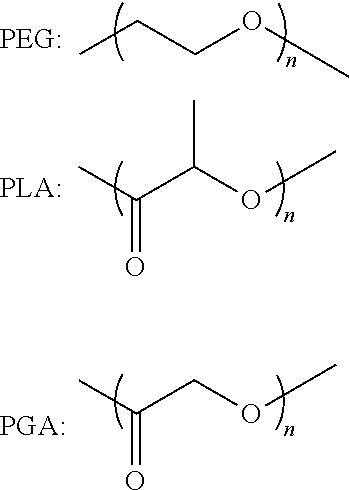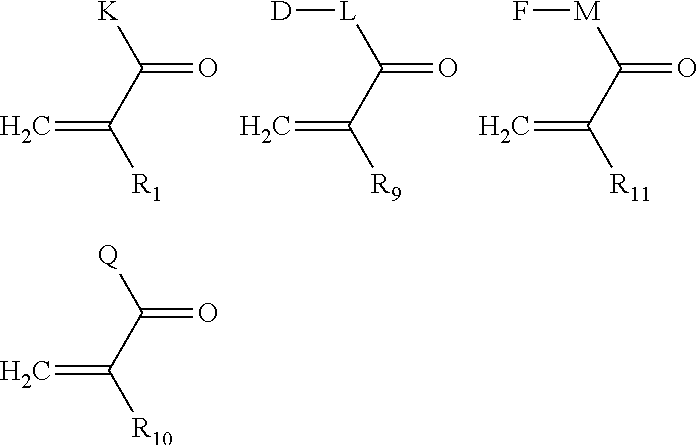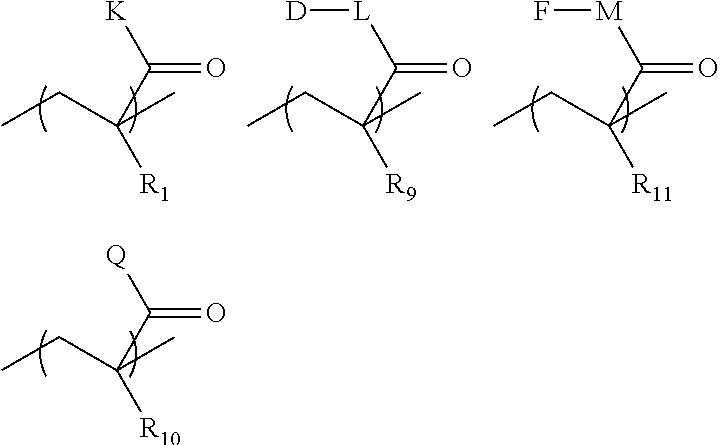Implantable bio-resorbable polymer
a bio-resorbable polymer and implantable technology, applied in the direction of capsule delivery, cardiovascular disorder, drug composition, etc., can solve the problems of incompletion of the solution, loose shape and resistance, and the resorbtion time of the plug will also take a variable time, so as to control the swelling of the polymer
- Summary
- Abstract
- Description
- Claims
- Application Information
AI Technical Summary
Benefits of technology
Problems solved by technology
Method used
Image
Examples
example 1
1. Synthesis of the Bio-Resorbable Cross-Linker by the HEMA / PEGMA Method:
1.1. PLA
First Step:
[0088]In a dry schlenk containing a magnetic stirring bar, lactide (2.2232 g; 0.0154 mol) and hydroxyethyl methacrylate (0.75 mL; 0.0062 mol) were dissolved in 5 ml of toluene under nitrogen. The reaction was initiated by introducing a toluene solution of Sn(Oct)2 (8 mg) into the above system. After 20 h at 90° C., 5 ml of chloroform was added to dilute the reaction mixture and the formed polymer was purified by precipitating in a large volume of petroleum ether. Yield 94%.
[0089]Characterization by 1H NMR in CD3COCD3: 1.53 (m, CH3, PLA), 1.91 (s, CH3, methacrylate), 4.38 (m, CH2, HEMA), 5.17 (m, CH, PLA), 5.65-6.10 (m, CH2═C)
Second Step:
[0090]The polymer formed in the first step was further modified through the hydroxyl group at the end of PLA chain by reacting with methacryloyl chloride. The preformed polymer (1.07 mmol of OH group, 1 eq.) was dissolved in anhydrous CH2Cl2 (2.5 ml) in a thre...
example 2
1. Synthesis of Ibuprofen Monomers:
1.1. HEMA-iBu:
[0121]The following reaction was performed:
[0122]In a round bottom flask containing a magnetic stirring bar, ibuprofen (0.34 g; 1.65 mmol) and 4-Dimethylaminopyridine (0.01 g; 0.09 mmol) were solubilized in dry CH2Cl2 (4 ml) under nitrogen atmosphere. Hydroxyethyl methacrylate (0.21 g; 1.65 mmol) and a mixture of dicyclohexylcarbodiimide (0.34 g; 1.65 mmol) dissolved in 2 ml of dry CH2Cl2 were sequentially added at 0° C. After reacting 24 h at 0° C., the mixture was filtrate and the crude product was purified on silica gel column (cyclohexane / ethyl acetate: 2 / 1).
[0123]Characterization by 1H NMR in CD3COCD3: 0.88 (d, CH3, isopropyl), 1.43 (d, CH3—CH, ibuprofen), 1.85 (m, CH3, methacrylate +CH-iPr, ibuprofen), 2.44 (d, CH2-phenyl, ibuprofen), 3.75 (q, phenyl-CH—COO—, ibuprofen), 4.31 (m, CH2, HEMA), 5.59-5.98 (m, CH2═C), 7.16 (dd, C6H4)
1.2. GMA-iBu
[0124]The following reaction was performed:
[0125]Glycidyl methacrylate (1.348 g; 9.5 mmol)...
example 3
[0137]1. Microspheres with a HEMA-PLGA Cross-Linker and a Hydroxyl Function:
[0138]A 0.5% of aqueous solution of 88% hydrolyzed polyvinylalcohol (300 ml) was introduced into a 500 ml reactor and allowed to stand under a nitrogen atmosphere for 15 min. The monomer phase containing poly(ethylene glycol)methacrylate (9.45 g; 17.97 mmol), poly(ethylene glycol) methyl ether methacrylate (5.47 g; 18.23 mmol), PLGA cross-linker (0.9 g; 1.52 mmol) and 1 wt % AIBN solubilized in 14 ml of toluene was degassed by bubbling nitrogen through the solution for 15 min. The monomer phase was added to the aqueous phase at 50° C. and agitated by means of a propeller type stirrer at an appropriate velocity so as to obtain monomer droplets of desired diameter. The temperature was increased to 80° C. and stirred for 5 h. The mixture was filtered hot and washed with water and acetone. Then, beads were freeze dry.
2. Microspheres with a HEMA-PLGA Cross-Linker and an Acid Function:
[0139]A 0.5% of aqueous solut...
PUM
| Property | Measurement | Unit |
|---|---|---|
| diameters | aaaaa | aaaaa |
| bio-resorbable | aaaaa | aaaaa |
| hydrophilic | aaaaa | aaaaa |
Abstract
Description
Claims
Application Information
 Login to View More
Login to View More - R&D
- Intellectual Property
- Life Sciences
- Materials
- Tech Scout
- Unparalleled Data Quality
- Higher Quality Content
- 60% Fewer Hallucinations
Browse by: Latest US Patents, China's latest patents, Technical Efficacy Thesaurus, Application Domain, Technology Topic, Popular Technical Reports.
© 2025 PatSnap. All rights reserved.Legal|Privacy policy|Modern Slavery Act Transparency Statement|Sitemap|About US| Contact US: help@patsnap.com



